#it’s this practice animatic I did last year to practice posing and such
Text

Thank you to everyone who joined me on stream this afternoon over on my channel! I worked on an SSAU animatic that I sketched out in Feb 2023 and it was a chill time ^^
#doctorsiren#hermitcraft#hermitcraft au#zedaphplays#wormman#evil xisuma#alexender void#snapshot au#ssau#animatic frame#wip#art#digital art#my art#fanart#procreate#I haven’t streamed in a hot minute haha#but it was fun to work on something I hadn’t touched in almost exactly a year#the animatic isn’t part 11#it’s this practice animatic I did last year to practice posing and such
125 notes
·
View notes
Text
Unit 3 Reflective Journal - Lim Lin Year 1 Production Arts for Screen
This unit introduced us to storyboarding and previsualization. The same script was given to everyone, and we had to break it down and create quick thumbnails for each scene. For my storyboard, I wanted to go for a more comedic tone for most scenes.
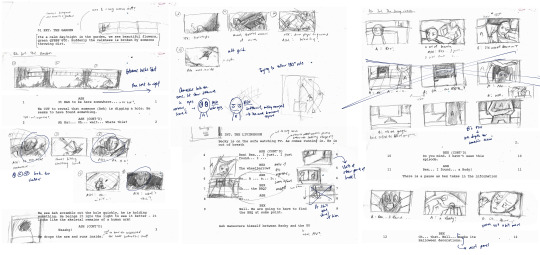
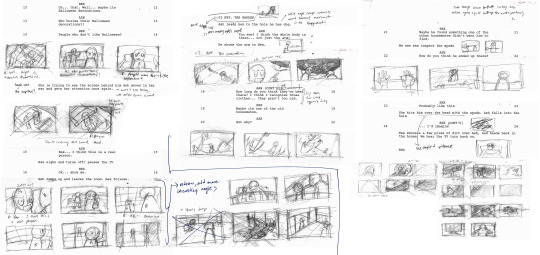
After the first rough sketches, I noticed many issues with perspective and staging in the shots drawn. Moreover, when looking at things from afar, many of the shots looked staged or repetitive. A bigger issue was the 180-degree rule which I struggled with, making some panels hard to follow.
For the tutorials, we were given quick exercises to draw different frames from various films in minutes using Photoshop. The horizon line and perspective were important to place subject matter in the frames correctly, and the goal for these exercises was to draw fast and to not go into detail. As I am slow at drawing, I struggled to do the first few exercises as the thumbnails were not clear enough and kept redrawing parts, then ended up not having enough time to finish.

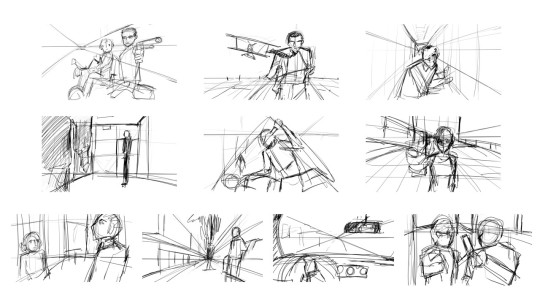
The next week, we focused on figure drawing. Emphasis was placed on gestures rather than the anatomy of the models shown on the screen. We were reminded frequently to draw with the line of action and avoid focusing too much on the muscles. Using the line of action, a figure can be drawn faster and quicker with energy and movement.
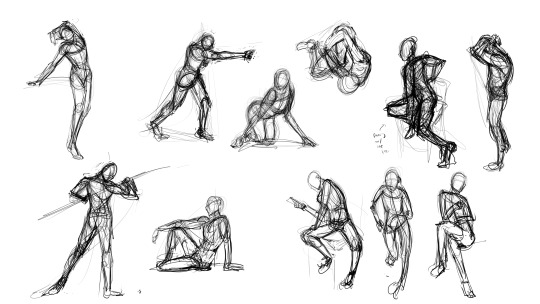
The drawing gets built up with structure and form and supported by paying attention to the areas of tension and structure of the form. An advice that helped me a lot was the guideline that the angle of the shoulders and hips should be the opposite of each other, though there were some photographs which had the angles hard to identify. Drawing from the feet upwards also helped me balance the figure more but it is still hard to achieve.
We also did another gesture drawing exercise traditionally using charcoal. Using a physically larger canvas gave me a clearer idea of how to make poses look less rigid.

After more practice, I began to work on the storyboard drafts. By drawing on larger spaces on the paper, I was able to draw the panels clear enough to trace on Photoshop.

For the first scene, to make the monologue less repetitive, made the camera zoom in and out of Ash more often. However, the part where he puts down the spade and picks up the arm seems out of place. For the final animatic, two more panels are added in between to create a better flow.

On paper, the walking shot from his point of view seemed okay but after adding it to premiere pro I realised the timing was too short so I added another panel of him walking to slow the pace down to create suspense. For the last few shots of this scene, I wanted to make the angles more dynamic. The scene of him dropping the arm out of fear is titled to show his shock and fear, and the part where he runs into the house is shot from a wide high vantage point to make him appear smaller as if overwhelmed by the environment.
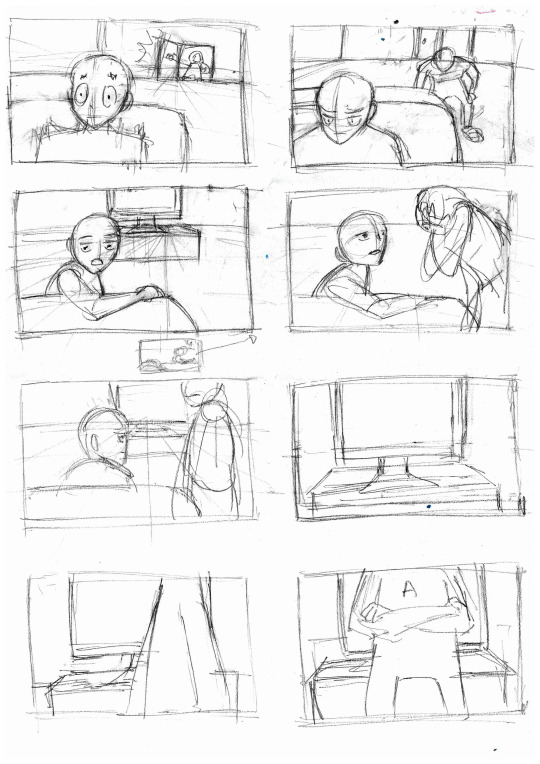
The next scene has more comedic lines and mainly focused on the two character's dialogue so the compositions are flatter and closer shots are used to focus on their upper body language and facial expressions.

The exception of this was the point when Ash desperately pleads Bex to take him seriously as she seems indifferent towards the morbid idea that a dead body is in their garden.

The scene ends with Ash dashing out of the house to show Bex what he discovered.
For the third scene, I already started on the animatic and cleaned the previous scenes digitally, so I did not have time to fix the rough storyboards on paper and instead worked on the remaining panels on Photoshop. As such, I also included the formatted storyboard for the last scene in this blog.
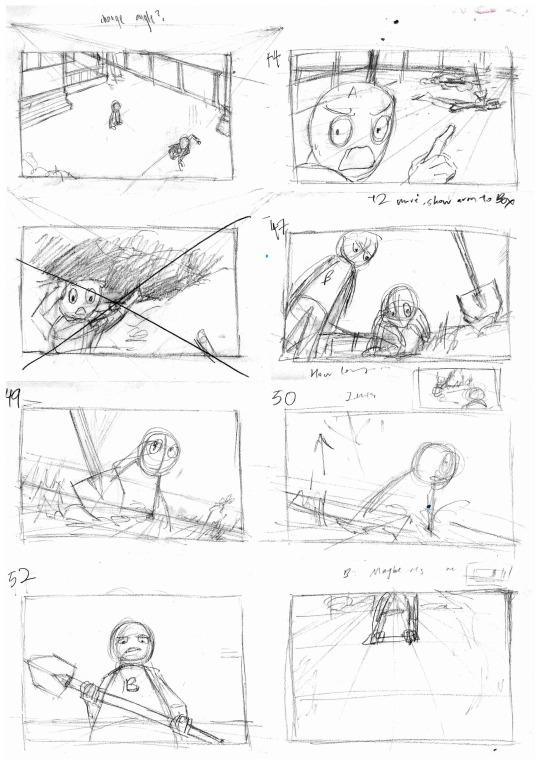

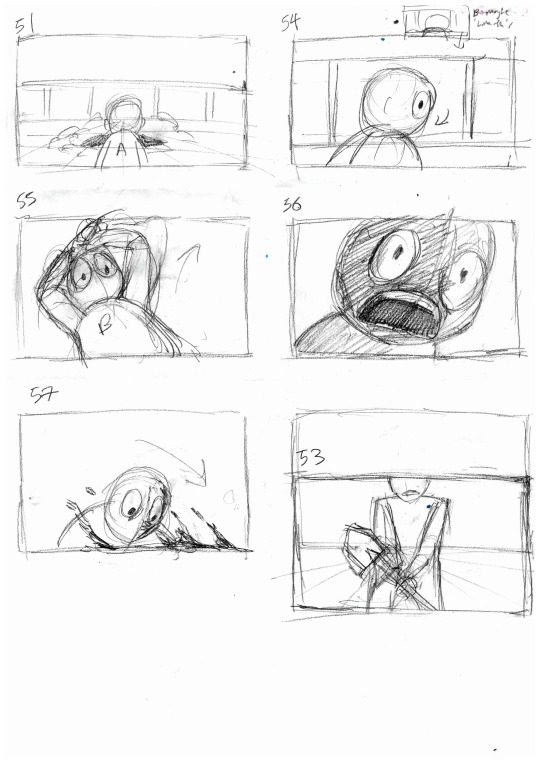
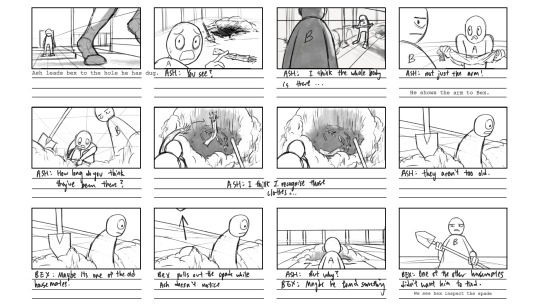
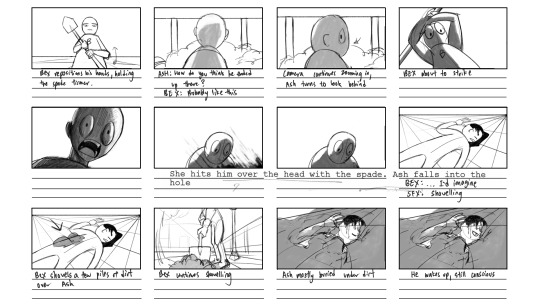

I tried using as many dynamic angles as possible as well as sharp shapes with the spade. I didn’t really use many references from other films for this unit but did so for the last scene as I needed to learn how to create suspense and action. Because the story is mainly lighthearted, I decided to use implied violence. Thus, the part where Bex hits Ash with the spade was referenced from this scene in American Psycho.

I thought this worked well with the storyboard as it follows a similar context of an oblivious person not aware of the murder setup of the more dominant figure, in my case Ash and Bex respectively.
For the hand-in, we were given a brief introduction to premiere pro as it will be the video editing software used for the animatic and previs. The main thing to keep in mind was the organisation of files as it is easy to lose media when transferring files across devices, which I experienced multiple times because of wrong file locations.
The Previs is to be made using blender as there are several things to take note of for the process to be done quickly. The shots made in 3D are meant to be throwaway art that is easy to make, so we were told to keep things simple and only model what is visible. What should be focused on is the shot's composition, clarity and timing. Like premiere pro, it is also good practice to make collections and to keep things in groups. Every single shot is a separate blender file, and the timeline is the number of frames in each shot.

For most scenes, I used a focal range between 35-15mm for more dynamic angles. I also used the sapling tree gen addon for the leaves, which helped a lot to make the lighting more effective for the setting of a garden.
The result looked like this when comparing the previs with the animatic for scene 1. To create the establishing shot, I used after effects and blender keyframes then imported the video files back into premiere pro.
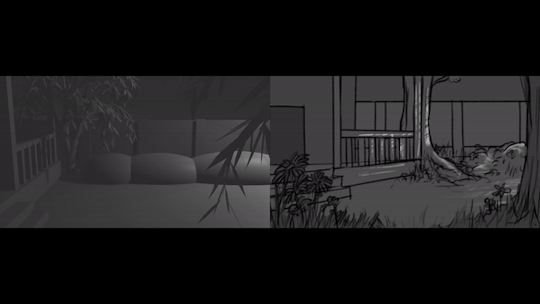
Animatic: https://artslondon-my.sharepoint.com/:v:/g/personal/l_lin0320231_arts_ac_uk/EY_ypRbvIwFBki4taSGtOaIBNeLFT2Ro5l1go4EiA1VqNg?e=9amh7F
Previs: https://artslondon-my.sharepoint.com/:v:/g/personal/l_lin0320231_arts_ac_uk/EemLgbhE-29NlVcD5_AGvS0Bhi1cmr7oJtFlUNFCGOR07Q?e=SW38pW
In case the OneDrive links won’t open, I have also uploaded them below on this blog.
Overall, If I had managed my time better, I would have wanted to use more references and created character designs to distinguish the two figures better. On the other hand, I felt that this unit helped me to address a big problem in my work which is my drawing speed and clarity which I think had improved over the month. I hope I would be able to work more efficiently in future animation units.
0 notes
Text
Blog 7 - Meeting Mair Perkins
The practicioner I chose to meet was Mair Perkins, a local freelance illustrator and animator who went to Derby University and chose to stay here. Having talked to her a few times on Facebook, and being a fan of her art, I felt that it would help if I met someone I at least sort of knew. Below is a summary of the answers she gave to my questions.
1. What are her current projects?
At the time of the interview, she was working on a project for a car leasing company on an Animatic Custom Computer. She is very organised, and has a calendar to keep up to date with her projects, and she had blocked out two months for her current one. She was using a computer with three curved screens, which is more immersive and helps with the process.
2. What is her process?
For animation, it starts with getting a brief and a script. She then works on the concept and the storyboards. Then the voiceover, and the animation production. The project then reviewed, and if it is satisfactory, delivered to the client.
3. Does she enjoy her work?
She doesn't always like her briefs, but at this stage in her career she can be choosier with what she takes on. It helps that she has built up a client base, and says that this is very important.
4. How do you balance work and home life, and do you get much time for personal projects?
She doesn't get much time for personal projects - when not working on a brief she normally works on her marketing. This includes working on her website, and on her social media like her Instagram. Having a studio helps the balance of work and home life, as well as with time management.
5. How did she get into freelancing?
She did animation at University, and ended up kind of falling into freelancing during the recession. Things were difficult job-wise, and she found that she like freelance better than conventional employment.
6. What are her inspirations?
A site called Wine After Coffee, which features many animation and graphic artists, and is an opportunity for them to showcase their work, especially their developmental work.
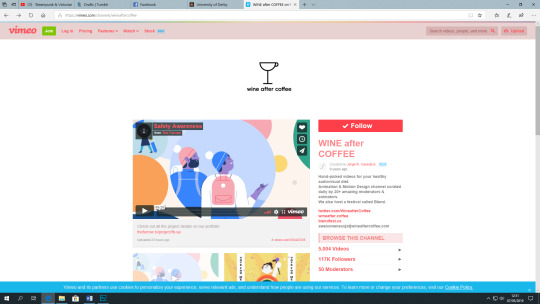
7. What made her get into illustration?
She did fine art in college, but found she didn't like it, and was told that she was better suited to Illustration. She did a BTEC, and did a combined Illustration and Animation course. She changed course the next year.
8. Why Illustration and not fine art?
Fine art is more to do with self expression, and she preferred to do fantasy art. Illustration and animation allows her more freedom in this.
9. Does she enter competitions?
She doesn't enter many competitions, but says they are very good for building up your CV and portfolio.
10. How is she for deadlines?
She always meets her deadlines, but admits that she was always a last minuter at Uni (obviously I related to this very much indeed).
11. Does she have any tips for time management?
Unplug the internet!!
12. What is her favourite part of her work?
Character animation, and rigging the parts separately. The characters are done in Adobe, and any illustration is done with a tablet (she recommends using a tablet).
13. Any other pieces of advice?
Drawing wise, tracing images is perfectly fine for practice. She also recommends doing life drawing courses, as they are extremely helpful for things like anatomy, scale and poses.
Overall, I thought that it went extremely well. Mair was very friendly and professional, answered all my questions, and did not mind that I was a bit nervous. The idea of freelancing has intrigued me, and I am interested to find out more about it.
Action Plan:
Research more about freelancing.
Have a proper look at Wine after Coffee.
Look up Illustration Post-Grad courses, as fine art does not sound quite my thing (like Mair I also like drawing fantasy and sci-fi art).
Find out what competitions I could enter in the future (especially on Zealous)
Find out ways to be more productive
Work out what other artists I'd like to meet (even if not for this module it could still be useful for the future)
0 notes